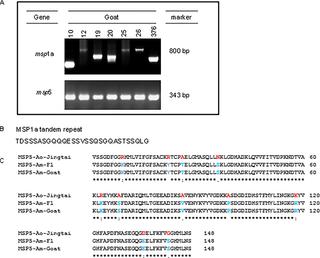PLOS ONE ( IF 2.9 ) Pub Date : 2018-08-13 , DOI: 10.1371/journal.pone.0202140
Nayara B. da Silva , Naomi S. Taus , Wendell C. Johnson , Anabela Mira , Leonhard Schnittger , Jessica D. M. Valente , Odilon Vidotto , Hayley E. Masterson , Thállitha S. W. J. Vieira , Massaro W. Ueti , Rafael F. C. Vieira

|
Anaplasma marginale, the causative agent of bovine anaplasmosis, is a tick-borne bacterium that causes significant economic losses for cattle industries and is increasingly being detected in other animal species. Rhipicephalus microplus is the main vector of this bacterium and may be found parasitizing small ruminants. In northeastern Brazil, multispecies grazing is a common family subsistence practice on smallholder farms possibly facilitating interspecies transmission of pathogens. Considering that A. marginale infection has been previously molecularly described in sheep, this study has aimed to estimate the prevalence of A. marginale and factors associated with the infection in goats from northeastern Brazil. A total of 403 goat blood samples were included in the study. An epidemiological questionnaire was applied to each farm owner addressing age, gender, presence of ticks and multispecies grazing. All samples were screened for A. marginale- and A. ovis-infection using primers targeting the Anaplasma spp. msp4 gene. The identity of A. marginale in the blood was confirmed by PCR amplification of msp5 followed by sequencing. Anaplasma spp. were differentiated by sequencing of the repeat region of the msp1α gene. For the statistical analysis the Chi-square or the Fisher’s exact test was used to verify association of the individual factors (age, gender, presence of ticks, and multispecies grazing) with Anaplasma spp. infection. We report the first molecular detection of A. marginale in goats from northeastern Brazil, based on msp1α, msp4 and msp5 gene sequencing analysis. Sequencing of the detected A. marginale msp1α gene revealed the F repeat. Amblyomma parvum and R. microplus were found feeding on animals.
中文翻译:

巴西山羊边缘无浆膜感染的首次报道
牛厌食症的病原体边缘无浆膜是a传播的细菌,它对养牛业造成重大经济损失,并在其他动物物种中越来越多地被发现。Rhipicephalus microplus是该细菌的主要载体,可能寄生于小反刍动物。在巴西东北部,放牧是小农户普遍的家庭生计方式,可能促进病原体的种间传播。考虑到一个。先前已经在绵羊中对边缘感染进行了分子描述,该研究旨在评估A的患病率。边缘以及巴西东北部山羊感染的相关因素。该研究总共包括了403个山羊血样。向每个农场主应用了一种流行病学调查表,其中涉及年龄,性别,壁虱的存在和多物种放牧。所有样品中筛选出一个。marginale-和一个。ovis-使用针对无形体属物种的引物进行感染。msp4基因。A的身份。通过msp5的PCR扩增,然后测序来确认血液中的边缘蛋白。无形体属。通过测序的重复区来区分msp1α基因。为了进行统计分析,卡方检验或Fisher精确检验用于验证个体因素(年龄,性别,壁虱的存在和多物种放牧)与无形体属的关联。感染。我们报告了A的第一个分子检测。边缘无来自巴西东北部山羊,基于msp1α,MSP4和MSP5基因测序分析。检测到的A的排序。边缘msp1α基因揭示了F重复序列。花蜱孢子虫和- [R 。发现microplus以动物为食。































 京公网安备 11010802027423号
京公网安备 11010802027423号